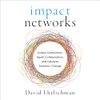Impact Networks: Create Connection, Spark Collaboration, and Catalyze Systemic Change
amazon.com
Saved by Manu and
Impact Networks: Create Connection, Spark Collaboration, and Catalyze Systemic Change

Saved by Manu and
People in distinct clusters tend to be more like-minded, have shared language, have similar conversations, and be located in the same region. Network limitations arise when clusters remain separated without a bridge to connect them. Bridges are essential links between two parts of a system that would otherwise be disconnected
Convening is the art of gathering people together simultaneously, whether in person or online, to experience the whole system. Successful convenings create a generative space where people interact, think, talk, and collaborate together in new ways.
cultivating relationships that would foster creative thinking and cooperation over the long term.
Ferguson goes on to assert that “the problem is that networks are not easily directed towards a common objective. . . . Networks may be spontaneously creative but they are not strategic.”
consistent. The work of cultivating and sustaining impact networks involves five core activities. For ease of reference, they are referred to as the “Five Cs”:
to articulate the purpose of the network from their perspective by completing the phrase “How do we . . . ”
our experiences have taught us to start somewhere between twelve and twenty-four participants for the launch of most new action networks.
Weavers engage with participants to gather input, introduce participants to each other to inspire self-organization, and build bridges with new communities to help the network grow.
Human and biological networks (like the networks of neurons in our brains) in particular have been shown to have a “breakpoint,